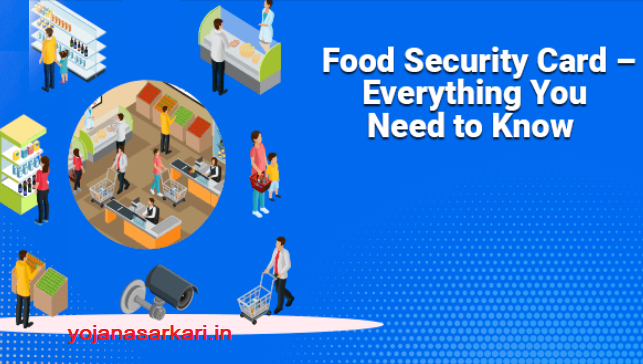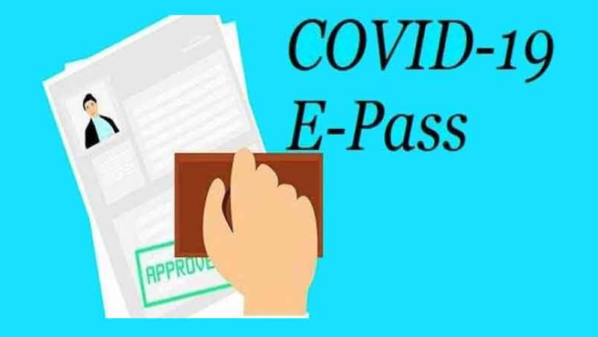Food Security Card:-
A government-issued card or program known as the Food Security Card enables qualified families or individuals to receive subsidized necessary food products. Ensuring that every citizen has access to enough food to sustain a healthy and active life is its key goal. By offering assistance to individuals who are struggling financially and finding it difficult to obtain basic sustenance, the card helps to address the problem of food insecurity.
In this article, we will share all the important details about the Food Security Card like eligibility criteria, application process, etc. For people or families in need, it is essential to know who is eligible for this program and how to apply. People will have a better knowledge of how to utilize this essential social welfare program by learning the eligibility conditions and the application process.

Food Security Card 2024
The Food Security Card’s subsidized food benefits reduce financial stress on low-income families. The program helps families focus their limited financial resources on other essential needs such as housing, utilities, health care, and education by providing basic goods at subsidized prices, thereby reducing food costs.
Thanks to the financial assistance of the Food Security Card, families are able to reallocate their financial resources. Families who are able to afford food can redirect their savings toward other important needs that they may have overlooked due to the high cost of food. This reallocation raises the standard of living of households by promoting stability and overall well-being.
Role and Objectives
- Providing Subsidized Food: Giving eligible families access to subsidized food is one of the main functions of the Food Security Card. This ensures that people who are struggling financially have access to basic food, acting as a vital safety net.
- Addressing Food Insecurity: The card attempts to lessen the impact of food insecurity, which is the state in which people do not always have access to adequate food for a healthy and active life. It attempts to close the gap between financial hardship and access to nourishing meals by providing subsidized food items.
- Enhancing Nutritional Support: The card’s goal is to guarantee that the food it offers is nutrient-dense in addition to providing sustenance. It is an attempt to alleviate nutritional deficits as well as hunger, particularly in disadvantaged people.
- Promoting Social Equality: The program works to advance social equality by making sure that everyone, regardless of financial situation or social background, has access to a basic supply of food. It aims to level the playing field in terms of access to necessary resources and lessen inequities.
Food Security Card Benefits
- Effect on Nutritional Needs of Eligible Families: The Food Security Card makes a substantial contribution toward meeting eligible families’ nutritional needs. The initiative guarantees that these families may have a varied and nutrient-rich diet that could otherwise be financially unaffordable by giving them access to subsidized key food products. In particular, this support promotes improved growth and development, addresses malnutrition, and enhances general health, particularly for vulnerable groups including children, pregnant women, and the elderly.
- Importance of Having Access to Essential Foods: Having access to necessary foods is critical to maintaining a healthy, well-balanced diet. The Food Security Card’s subsidized food options aid in satisfying dietary requirements, increasing the consumption of essential nutrients, and lowering the chance of nutritional deficiencies. In addition to enhancing physical health, this access helps recipients’ quality of life, overall productivity, and cognitive development.
- Diminished Financial Stress on Low-Income Families: The Food Security Card’s subsidized food offerings reduce financial stress on low-income families. The program helps families focus their limited financial resources on other essential needs such as housing, utilities, health care, and education by providing basic goods at subsidized prices, thereby reducing food costs.
- Reallocation of Funds for Needed Expenses: Families are able to reallocate their financial resources thanks to the Food Security Card’s financial assistance. Families that have access to reasonably priced food might redirect their savings toward other important needs that they might have overlooked because of the high cost of food. The welfare and stability of the family as a whole are supported by this reallocation, raising their level of life.
Eligibility Criteria
- Income Criteria: One important factor that determines eligibility for a Food Security Card application is income. Usually, each nation or area has certain income requirements that candidates must meet to be eligible for the program. These cutoff points are determined by taking into account the local economy, average income, and cost of living. Families or individuals earning less than this amount are thought to be eligible for the Food Security Card.
- Documentation and proof Needed: Applicants must present a variety of official papers, such as income certificates, pay stubs, tax returns, or any other proof that attests to their financial status, to validate their income levels. These records are essential to the application process and act as proof of the applicant’s income status. They assist authorities in making sure aid reaches people who actually need it.
- Effect of Family Size on Eligibility: Another important consideration in establishing eligibility is the furnishings of the home. Larger families often have different needs or may be given larger rations to meet their greater dietary needs. The number of people living in a household has a direct impact on how many food stamps they are eligible for.
- Special Criteria for Large Families: Large families are subject to particular concerns in several areas. These standards can include special allowances for extra family members in recognition of the higher dietary needs of larger families. It is important for bigger families requesting assistance through the Food Security Card to comprehend these unique factors.
- Focus on Supporting Marginalized Communities: Food Security Card programs frequently give special attention to supporting underprivileged populations, such as scheduled castes, scheduled tribes, and other lower social classes. Food insecurity may be more common among certain social groups as a result of past injustices and socioeconomic difficulties. Thus, it may be necessary to modify the qualifying requirements to guarantee that these marginalized populations receive sufficient assistance.
- Particular Groups Eligible for Assistance: Pregnant women, nursing mothers, children, the elderly, and people with disabilities may be eligible for the Food Security Card in a particular way. Because of their perceived vulnerability, these groups receive special help from the program.
- Importance of Citizenship and Residency: The prerequisites for both are essential to the Food Security Card application procedure. These programs usually have the unique purpose of serving citizens or authorized inhabitants of a certain area or nation. To be eligible for the program’s benefits, candidates must be citizens or inhabitants of the relevant area.
- Documents and Proofs Needed: Candidates must provide any necessary evidence, such as citizenship certificates or proofs of residency, attesting to their status as citizens or inhabitants of the area. This paperwork acts as evidence of their eligibility to receive the benefits provided by the Food Security Card program.
Application Process
- Application Form:
- Details Required in the Application Form: The Food Security Card application form typically requests personal information such as name, address, phone number, family structure, income level, and any details related to vulnerable populations or socioeconomic categories. To accurately determine eligibility, the form attempts to collect detailed information.
- Explanation of Form Submission: The application form must be sent to the appropriate authorities when it has been completed with all necessary information. There are a variety of ways to submit information, such as through government websites, and application centers. One important first step in the application process is submission.
- Required Documentation:
- Types of Documents Needed: Typically, applicants must submit several supporting documents to authenticate the information on the application form. These documents may include proof of identity, proof of address, income certificates, family photographs, or special certificates related to participation in vulnerable groups or socioeconomic categories.
- Importance of Accurate and Up-to-date Information: It is important that the data in these pages should be current and accurate. This guarantees the validity of the application and assists in accurate evaluation and verification. Incorrect or outdated information may result in the application being delayed or even rejected.
- Submission Channels:
- Options for Submitting Applications: Several ways to submit applications: Online, through government offices, in special centers set aside for this purpose, or in person at government offices. Convenience and accessibility are the goals of these many channels for candidates.
- Pros and Cons of Various Submission Methods: There are advantages and disadvantages to every submission method. While online portals are convenient, they may not have the same personal touch as in-person submissions, which allow for direct engagement and doubt clarification. Having a clear understanding of these benefits and drawbacks will aid candidates in selecting the best approach.
- Verification Process:
- Overview of Verification Steps: Following submission, authorities carry out a verification procedure to confirm the information from the application and any supporting documentation. Interviews, field trips, and cross-verification with additional government databases may be required for this.
- Field Visits and Additional Documentation Requirements: To verify the information submitted, field visits to the applicant’s home may be necessary. It is occasionally possible to ask for more documentation to make sure the information is accurate. This is a critical step in preventing false claims and guaranteeing that the recipients of assistance are those who truly need them.
- Issuance of the Card:
- Details Mentioned in the Food Security Card: The card is issued after a successful verification. It usually includes information on the household, including the number of people living there, their entitlements, the kinds of subsidized foods they may get, and the quantity allotted. Beneficiaries use the card as a means of access and identification.
- Implications of the Card for Beneficiary Families: The card gives qualifying households access to necessary subsidized food items, which lessens their financial burden. It guarantees them a steady supply of essential foods, which greatly enhances their general health and nutritional requirements.



